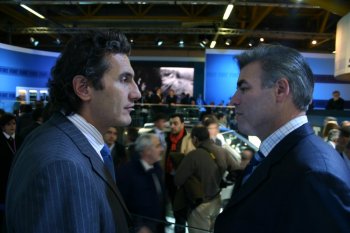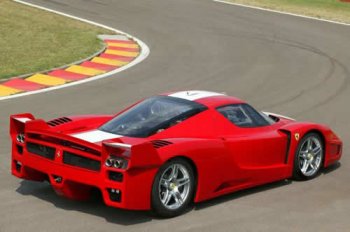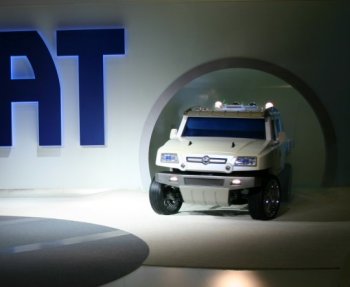|
"We
are working on a replacement for the Stilo, that will be a
hot product, Lancia may come out with a remake of the Delta
model, and the Fiat 500 will surprise a lot of people,"
Fiat's design chief Frank Stephenson recently discussed
several aspects of his new position
with
Gail Edmondson, the Senior European Correspondent for Business
Week magazine.
Morocco-born Stephenson is already famed for having penned the
iconic new Mini during a period he spend with BMW, before he
switched to Ferrari where he has overseen all their recent
evocative designs. Now, the Art Centre College graduate, has
taken over the top job at Fiat Centro Stile where he is
responsible for designing a
whole raft of forthcoming key models, including next
generation Fiat Stilo, a modern interpretation of the historic
Fiat 500, both of which are set to arrive next year, while 2007
will see the rebirth of Lancia's Delta hatchback.
The following excerpts are from his recent interview with
Business Week:
Fiat used to be the
European leader in small cars. Now the competition is
ferocious. What does Fiat have to do to regain some of its
lost ground?
You have to grab the customer from the beginning. To do that
with design, there are two approaches. The first is to use
shock value. The second is a more evolutionary approach that
plays off the brand's historic treasures. If an auto maker
has a rich history, you don't want to take off in a
completely new design direction, you want to handle the DNA
of the brand correctly to preserve the customer base. Fiat
definitely has a history of making cars that people loved.
Then it went through a hiccup where the quality went off
track, and design, too. We are taking it to the doctor and
bringing it back new life. We only have to make it healthy
again.
How do you do that?
You need to make cars with pure Italian-ness about them.
Everyone loves things made in Italy, because there is an
intensity to everything about this country -- lifestyle,
food, culture, fashion, and history. We have to get back to
Fiat's roots and make really, really attractive cars -- cars
that you fall in love with on the first look.
The auto industry's model cycle is roughly five years,
and designing a new car takes two to three. How fast can you
start to bring that new Fiat look to market?
With the new Punto, which was launched this fall, we have
made the first step in the right direction. The next
products will start to be shown within one year. You will
see cars that are full of sensual design.
How can you design a car in one year?
The design department at Fiat is a small group. We don't
have any committees, so there's no reason for us to take 24
to 36 months to develop a car. If a company is taking that
long, it probably means communications are not working well,
there are a lot of revisions going on, and you don't have
the right team with the right vision.
Which will be the first new models to hit the market?
We are working on a replacement for the Stilo -- that will
be a hot product. Lancia may come out with a remake of the
Delta model. And the Fiat 500 will surprise a lot of people.
In the light commercial vehicle market, we will show we have
our finger on the youth market -- our vehicle will be more
sexy than anyone else's.
What are the key trends in car design, and where are they
leading?
The secret and future of car design is personalization. Car
buyers want to be the only one to own a given product, so
any way you can offer the customer the chance to suit his
taste and be unique with materials, colours, wheel design is
important. And the ability to customise the interior of the
car.
For people in Abu Dhabi, for example, perhaps you offer
a bluish tinge to the light, which makes the car feel
cooler. In Finland, where it's 30 below zero in the winter,
you might offer a warm red haze to the interior lighting, to
warm the atmosphere up. We are also interested in materials
that have sparkle and light.
|


 |
|
Frank Stephenson
(centre, with Alfa Romeo CEO Antonio Baravalle at
the Bologna Motor Show) is responsible for designing
the iconic new BMW Mini (top), as well as styling the
Ferrari FXX (above), a supercar that is undoubtedly the ultimate expression of the
adaptation
of F1 racing technology. |
|
|


 |
|
One of the first
projects to be realised by Fiat Centro Stile under
the direction of Frank Stephenson, is the awesome 'Oltre
Fiat' showcar, which was shown in Bologna last month
after the project was completed in record time. |
|
What will we see in car design in 5 to 10 years that we
can't imagine today?
We will see innovation in luxury materials. I can't believe
in 10 years alloy, leather, and wood will be the only luxury
materials in cars. Everyone will try to find the next one.
Think about mother-of-pearl, ceramics, rocks, granite, or
marble. We could rethink the materials used for the grills.
How important is the interior design of a car?
The interior is the big battleground of the moment. It is a
way to win over the customer. The exterior may look good,
but if the interior doesn't convince, people will get rid of
the car. It's like falling in love with the mind and
character of someone, after being attracted to their face.
Unless you love the inside of the car, it won't do the
trick. We're all pushing for advances in interior design.
Everyone is doing different things with the instrumentation.
We may see 3-D effects, softer materials that feel better,
and ergonomically well-designed cars. It's a constant battle
to find some competitive advantage in interior design.
Do Europeans still hold the design leadership in cars?
No one speaks about emotionally charged American or Japanese
vehicles. They make normal, high-volume products. Chris Bangle really shook up the world of auto design
with the new look at BMW. He provoked a huge controversy
within the industry.
I respect Chris for what he has done. It takes a lot of
courage to go against the grain, and to do it with a company
that has BMW's weight in the industry. There's an element of
having done something correctly, and there is a period of
refinement to smooth out some of the new styling. Bangle has
been a hero -- he took courageous steps. Who is really leading the car design industry today?
It's not Mercedes, not BMW, not Ford. We are living through
a moment of confusion. Chrysler had it. The French had it,
but it didn't stick as well as it should have. There is
nothing beautiful like in the 1960s, where you really
drooled over cars. Design was like sculpture, artisans made
those surfaces. We've gone to aggressive-looking cars, you
don't want to run your hand over the car anymore. We've lost
that artistic, sculptured look. There are not many cars
where you'd say, "there was an artist at work here," where a
car was created by hand and not by computer. Cars have gone
digital. We will try to stay organic. You can't escape using computers, can you?
We have to use computers, to be fast. But we should have a
design language. The car should be massaged into shape,
instead of being milled. It's simplicity that is beautiful.
Like the iPod. It's so simple, but it's just right. I bought
one a year ago and I've never used it, but it's so
beautiful. It's a highly technical product, but it has a
purity and honesty to it. I want to try to get that kind of
design language back into the product at Fiat.
|
|
|
|
![]()
![]()